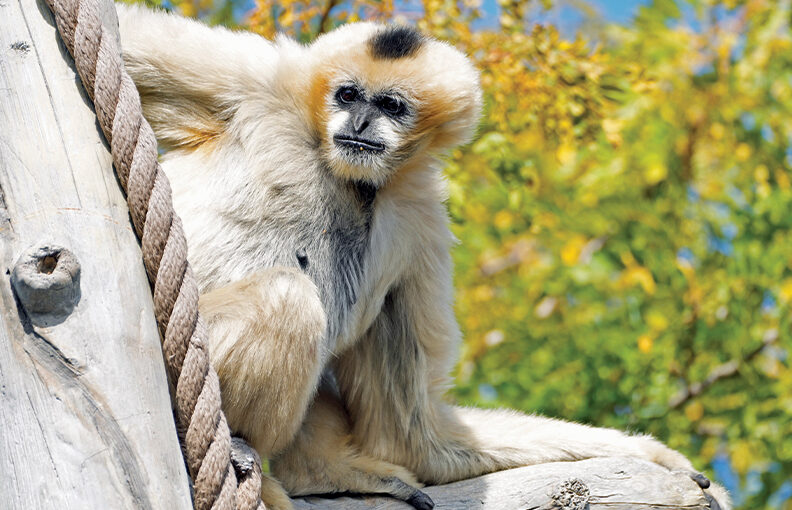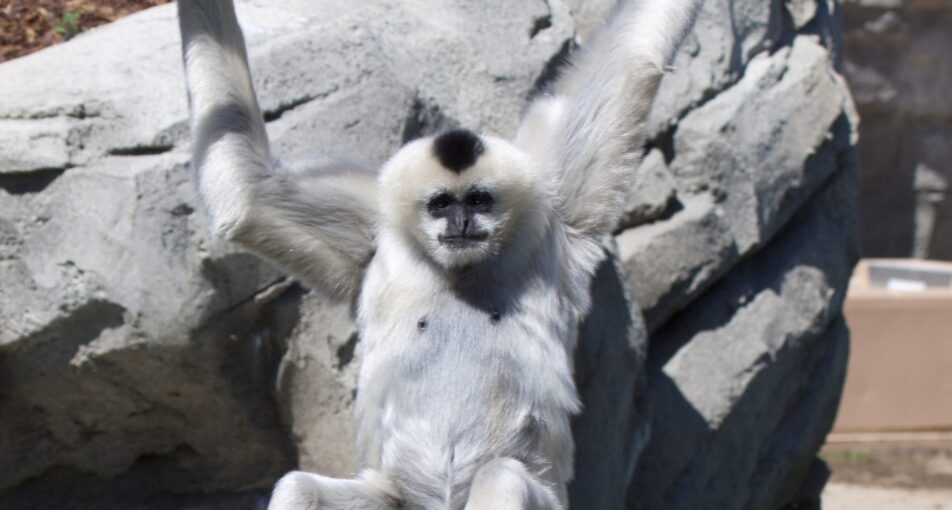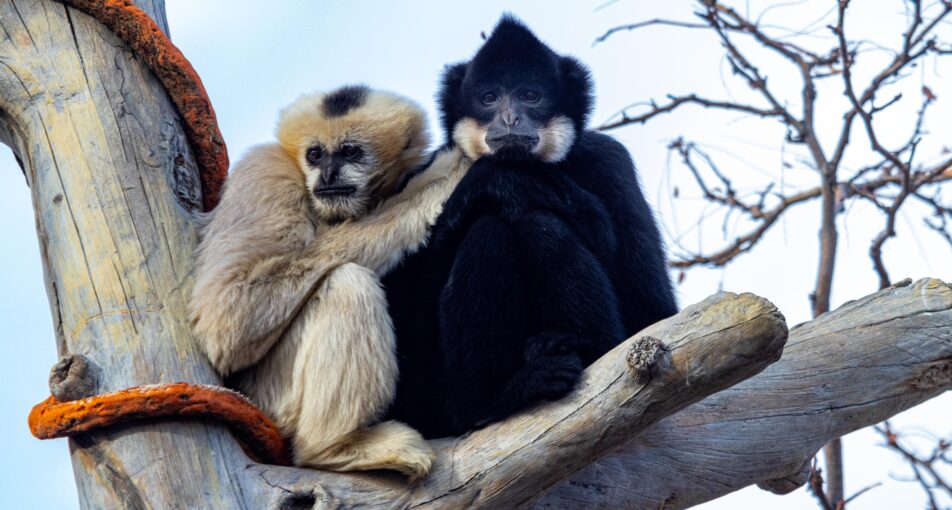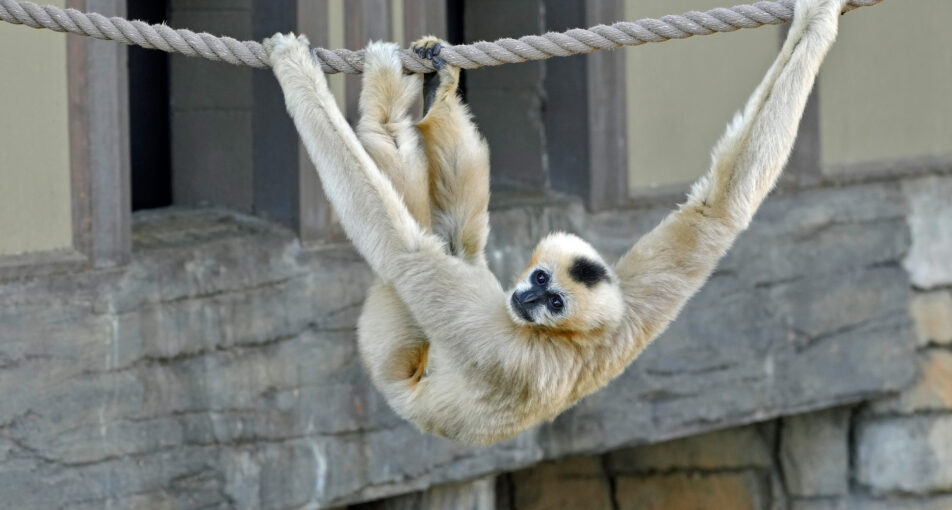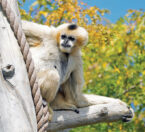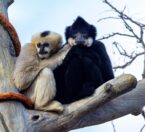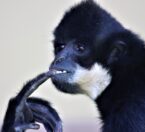White cheeked gibbons have melodic songs with long, pure notes rising and falling in a great call. Individuals signal territory by using vocalizations. They also use vocalizations in mating behaviors. Males and females participate in elaborate duets; the male emits booms and multi-modulated phrases and the female gives rapid great calls with rising notes, 20-27 notes, 13-15 seconds, with the male coda at the end.
Classification
| CLASS: | Mammalia |
| ORDER: | Primates |
| FAMILY: | Hylobatidae |
| GENUS: | Nomascus |
| SPECIES: | leucogenys |
Habitat & Range
White-cheeked gibbons live in the canopy of subtropical rainforests and prefer lowland forests with more diversity of fruit trees. However more recently with habitat loss most of these gibbons live above 700 meters. This species hardly ever descend to the forest floor.
This species is found only in Southeast Asia. They primarily populate Laos, Vietnam, and Southern China. In Vietnam white-cheeked gibbons are found to the southwest of the Song Ma and Song Bo Rivers.
Location


Adaptations
- Nomascus leucogenys, have exceptionally long forelimbs and hindlimbs. Their bodies are built for an arboreal lifestyle. They have opposable hallux (inner toe) and pollex (thumb) making grasping food and holding branches easy.
- Furthermore, their hands are hook shaped, facilitating brachiation (moving through the trees by grasping and swinging from branch to branch by the arms), and allowing them to remain suspended for feeding in the terminal branches where the most nutritious flowers and fruits are most abundant. .
- In order to signal aggression, these gibbons resort to the common threat of opening their mouth wide to show their teeth.
- White-cheeked gibbons spend much of their time grooming and playing. Grooming and playing allow individual gibbons to form bonds. It is also likely that chemical cues, such as pheromones are used to communicate reproductive status.
- Unlike other primates, white-cheeked gibbons do not sleep during the day; they search for food throughout the day, starting high in the canopy early in the morning and retreat to the lower tree understory when the canopy heats up.
- These gibbons will travel far in search of food when there is little rainfall.
Physical Description
- Gibbons are small apes with very long arms and no tail. Nomascus leucogenys are not sexually dimorphic for size, but are for color.
- Males and females are 45-63 cm (18-25 in) long and weigh and average of 5.7 kg.(12.5 lb).
- All infants are born with cream-colored fur. At two years of age, the infants’ fur changes from cream to black, and they develop white patches on their cheeks.
- At sexual maturity, males stay black with white cheeks. Females turn back to the original cream or pale yellow/yellow color and they lose the majority of their white cheek color, except for a thin white face ring. Females also have a black to brown crown streak
- They have exceptionally long forelimbs and hindlimbs. Their bodies are built for an arboreal lifestyle.
- They have an opposable hallux (innermost digit of the hind foot) and opposable pollex (thumb), and their hands are hook-shaped, for grasping food and branches
- Their bodies are small with an upright posture.
- The fur in both sexes is long and rather coarse. The crown hair is erect and rather elongated.
Diet
What Does It Eat?
In the wild:
Nomascus leucogenys are primarily frugivouous, with fruit comprising 39% of their diet .They especially enjoy eating the pulp of fruits. They are important seed dispensers for some plants. Along with fruit, a large portion of their diet consists of leaves and shoots( 36%),and they also eat flowers, and insects. The type of food they eat depends on precipitation. When it is wet, fruit is plentiful, and they don’t have to travel.
At the zoo:
Gibbons are fed greens, vegetables, low starch biscuits, konjac gel, and some fruit for training.
What Eats It?
The main threat to white-cheeked gibbons is forest clearing , and therefore their main predator is humans, who also hunt them for food. Otherwise not much is known about other specific predators, but eagles, owls and panthers are known to prey on other gibbon species who live in the canopy.

Social Organization
White-cheeked gibbons live in small families comprising a male adult and a female adult that mate monogamously. They usually have three to four offspring within the group. There is an hierarchy among the family. The female is dominant followed by her female offspring, male offspring, and the adult male is last. Nomascus leucogenys individuals spend much of their free time playing and grooming. They are territorial and live in an area that spans about seventy-five to one hundred acres, and they defend their territory.
Life Cycle
White-cheeked gibbons become sexually mature at about six to seven years of age. At this point, females have a menstrual cycle that lasts about twenty-eight days. They breed throughout the year. After a gestation period of seven months, a single infant is born. The infant stays with the mother for nearly two years, after which it is weaned. White cheeked gibbon offspring will stay with the family group until it becomes independent between 3-8 years. Females bear young every 2-3 years and infant care is shared between the male and female of the monogamous pair.
